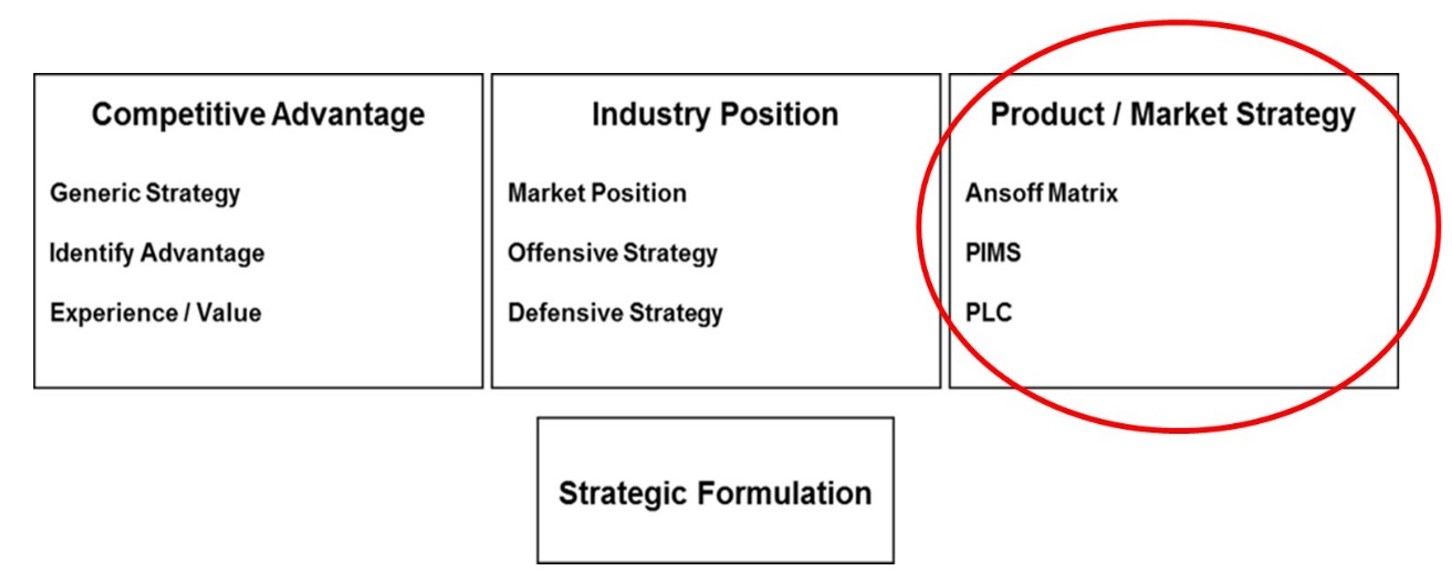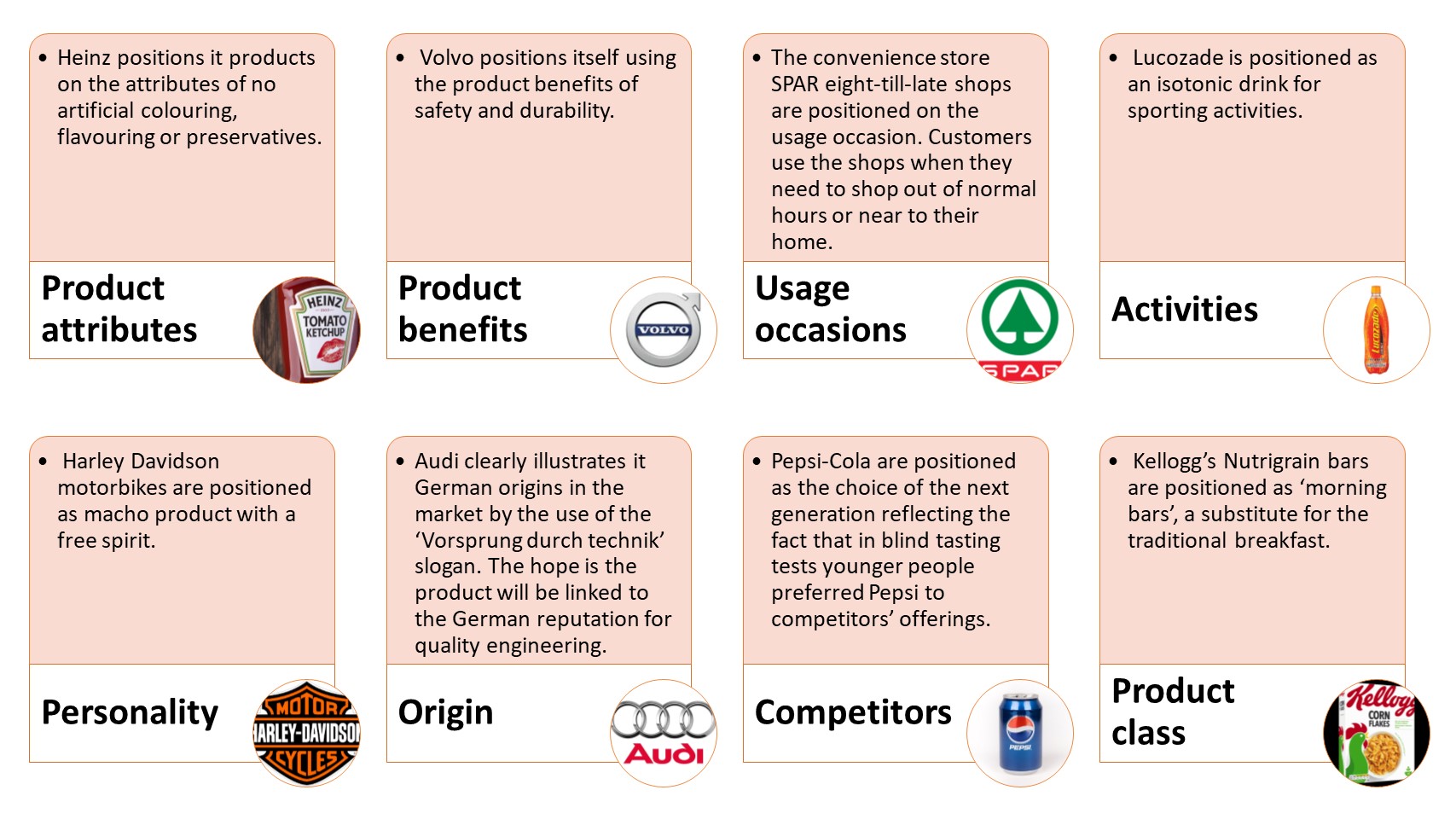
Product/Market strategies are detailed in nature. They address the specific market impact of a product or product line. This section examines three concepts useful in formulating such strategies: the product/market matrix, PIMS analysis and the PLC.
Ansoff Market Matrix
Ansoff (1975), developed a policy/market matrix (or ‘Ansoff’ matrix) which provides a useful linkage between products and markets. The matrix considers four combinations of product and market. Each combination suggests a growth strategy.

The organisation’s potential is determined by the combination of current and new products within current and new markets. Additionally, the element of risk must be considered. As organisations move away from existing markets and products the potential risk factors increase.
Market penetration: The aim is to increase sales of existing products in current markets. An aggressive marketing drive, through factors such as competitive pricing, sales promotion or advertising, can expand the share of an existing market. Dealing with familiar customers and products is low risk and provides a starting point to planned growth. However, the potential for market penetration is often limited and strategic plans may require additional options to be pursued.
Market development: Market development aims to find new markets for existing products. This could involve new geographic market (e.g. exporting), adding distribution channels or finding new market segments. For example, a manufacturer of sports clothing may try to position its products as fashion items and target a different set of retailers.
Product development: Organisations must update their product portfolio to remain competitive. Ideally, a balanced product portfolio should exist, with established products generating funds for product development.
Diversification: This involves moving beyond existing areas of operation and actively seeking involvement in unfamiliar activities. Diversification can be related – having linkages to existing activities, or unrelated – venturing into totally new activities. While unrelated diversification may spread risk, it can be difficult to achieve.
Click here to view a video that explains an example of market matrix.
PIMS Analyses
Many influential marketing studies have examined the link between profit and marketing strategy. The PIMS (profit impact of market strategy) studies aimed to identify the key drivers of profitability and have recognised the importance of market share as such a driver. Generally speaking, profits will increase in line with relative market share. This relationship has influenced marketing thinking, promoting actions aimed at increasing market share as a route to profitability.

The Profit Life Cycle

The PLC has been described as the most quoted but least understood concept in marketing. Any strategy considering products and markets will be influenced by the PLC. Products pass through four stages: introduction, growth, maturity and decline. Sales will vary with each phase of the life cycle.
It takes time for sales to grow and the introductory phase sees awareness and distribution of the product increasing. Some organisations will specialise in innovation and aim to consistently introduce new products to the market place. Common strategies include:
Skimming, where a high price level is initially set, in order to capitalise on the product’s introduction and optimise financial benefit in the short term, or
Penetration, with pricing being used to encourage use and build market share over time.
Growth
This phase sees a rapid increase in sales. Additionally, competition begins to increase and it is likely that prices will be static, or fall, in real terms. The growth stage sees the product being offered to more market segments, increasing distribution and the development of product variations.
Maturity
Here product sales peak and settle at a stable level. This is normally the longest phase of the PLC, with organisations experiencing some reduction in profit level. This is due to the intense competition common in mature markets. As no natural growth exists, market share is keenly contested and marketing expenditure is increased. Marketers may try to expand their potential customer base by encouraging more use or finding new market segments.
Decline
The decline stage can be gradual or rapid. It is possible to turn-around declining products and move them back into the mature phase of the cycle. The alternative is replacement. A residual demand will exist, with current users needing parts, services and on-going support. Often the decline phase offers a choice, re-investing (turn-around/replace) or a ‘harvesting’ strategy that involves maximising financial returns from the product and limiting expenditure.
Click here to view a video that explains the product life cycle practically.
Strategic Wear-Out
The adage – ‘nothing lasts forever’ – is certainly true of marketing strategy. Care must be taken to avoid strategic wear-out. This occurs when the organisation no longer meets customer needs and the pursued strategy is surpassed by competitors. Davidson (1997), summarises the causes of strategic wear-out:
- Changes in customer requirements
- Changes in distribution systems
- Innovation by competitors
- Poor control of company costs
- Lack of consistent investment
- Ill-advised changes in successful strategy
Future business requires active steps to ensure that your strategy does not ‘wear-out’ and the role strategy formulation is to develop/maintain a marketing orientation. This is based on the premise of defining customer need and prospering through customer satisfaction and loyalty. Sound general and financial management should underpin this orientation and the entire corporate focus should relate to key asset of any business – customers.
Positioning Your Company In A Specific Market Segment

Evaluating Market Segment
To effectively evaluate different market segments, it is necessary to systematically review two issues: the market attractiveness of the competing segments and the organisation’s comparative ability to address the needs of that segment. There are a number of criteria that can be used to judge the attractiveness of a market segment.
When assessing market attractiveness, the particular features of a market will affect any evaluation.
Segment size: A large segment will generally have greater sales potential. This in itself will make it more attractive but it may also offer the potential of gaining economies of scale because of the larger volumes involved. Large segments with their potentially larger sales can justify the higher investments that may be necessary for organisations wishing to operate within them. However, large segments may not always be the most attractive. Large segments can be more competitive as their very size will attract other companies into them. Smaller organisations may not have the resources to address a large market and therefore may find smaller segments more appropriate for their attention.
Segment’s rate of growth (measured in terms of real revenue growth after inflation): Segments that are growing are normally seen as being more attractive than segments where growth has peaked or even begun to decline. Segments in growth are seen as having a longer-term potential and therefore justify any investment necessary. These segments are likely to be more competitive as other companies also recognise their potential.
Segment’s profitability: What is the total profitability of the segment? If you are already operating in this segment, it is not your organisation’s profitability alone that should be reviewed. In order that all segments are evaluated on a consistent basis, it is the profitability of all companies operating in the segment that should be calculated. This will have to be an estimate based on analysing competitors’ activities.
Customers’ price sensitivity: Segments where consumers have low price sensitivity are likely to be more attractive as higher profit margins can be gained. Consumers will be more concerned about quality and service rather than price alone. Price sensitive segments are more susceptible to price competition, which leads to lower margins.
Stage of industry life cycle: Entering a segment that is in the early stages of an industries life cycle offers the advantages of potentially high growth in the future. In the early stages, there are also likely to be less competitors. However, the early stages of the industry life cycle are characterised by the need for high investment in new plant, promotional activities and securing distribution channels. This occurs at a time when there may only be modest sales revenue. There will be a drain on cash into the new area of business that the company has to be able to fund. Businesses that are more interested in cash generation or profits in the short term may consider mature markets more favourable. These markets are likely to require a more modest level of investment.
Predictability: The potential value of a market will be easier to predict if it is less prone to disturbance and the possibility of discontinuities. In the long term, a predictable market is likely to be more viable.
Pattern of demand: The attractiveness of a segment will be affected by any seasonal or other cyclical demand patterns it faces. A large percentage of sales in the gift and card market take place at Christmas in western countries. An organisation has to be able to withstand the cash flow implications of this skewed demand. The same problem occurs in other industry sectors such as travel and tourism.
Potential for substitution: In any market there is the potential for new solutions to be developed that will address consumers’ needs. An organisation should review markets to establish whether new innovations could be used in the segment. Where substitutions are likely, an organisation may decide not to enter on the basis that it makes the segment less attractive. If, however, the organisation has the ability to deliver that innovative approach it may make the segment a prime target as the company has the skills to change the nature of competition to their advantage.
Targeting A Market Segment
The critical stage in the segmentation process is matching the capabilities of the organisation to attractive market segment opportunities. At a largely operational level management analyse organisational assets and competencies to identify the skills and resources available to build low cost or differentiated positions. Where these assets or competencies currently, or with development could, surpass the competition, they form the basis for creating a specific competitive position in a target market.
Company capability should always be judged relative to the competition. Overall, the organisation has to establish whether entering a particular segment is consistent with its long-term aims and objectives. If not then no matter how tempting, entering the segment should be resisted. It will only divert company resources and management time away from the core goals of the enterprise.
Once the key areas of a company’s capabilities have been identified, can they be aligned with the attractive market segments already identified. An organisation should enter segments that allow it to exploit current assets and competencies, or will allow potential capabilities to develop into strengths.
Brand Positioning In A Market Segment
Having selected a target market or markets the organisation then has to decide on what basis it will compete in the chosen segment or segments. How best can it combine its assets and competencies to create a distinctive offering in the market? This has to be done in such a way that consumers can allocate a specific position to the company’s product or service within the market, relative to other products.
Consumers have to cope with a huge amount of product information. Customers will position a product in their mind in relation to other products on the market based on their perception of the key attributes it contains.
Consumers will see the key attributes of Volvo as safety and durability. BMW’s main attributes are based on performance hence the ‘The Ultimate Driving Machine’ advertising slogan. When consumers consider the car market, these two companies’ products will be positioned relative to each other based on these perceptions.
Companies can attempt to associate various qualities to their product as a way to help shape consumers perceptions of their position in the market. A brand can be positioned using a range of associations such as:

Four Factors Are Of Critical Importance For Successful Product Brand Positioning
Credence: The attributes used to position the product have to be perceived to be credible by the target customers. It would be very difficult for a nuclear power generator to position itself as environmentally friendly.
Competitiveness: The product should offer the consumer benefits which competitors are not supplying. Clairol launched a new shampoo Herbal Essences in the USA in 1995 which emphasised the brand’s wholesome ingredients. By 1997 this was the fastest growing brand on the market and ranked number two behind Pantene.
Consistency: A consistent message over time is invaluable in helping to establish a position against all the other products and services fighting for a share of the consumers mind. An organisation that changes its positioning on a regular basis causes confusion in the consumer’s mind. This will mean they have an unclear perception of exactly what are the key characteristics of the product.
Clarity: The positioning statement an organisation chooses has to create a clearly differentiated position for the product in the minds of the target market.
The overall aim of branding decisions is to create an identity for the product or service that is distinctive and in line with the targeting and positioning decisions already taken. Organisations should strive to produce a brand equity that delivers value to the consumer. This will result in the customer either showing greater brand loyalty or being willing to pay a premium price for the product. Brand equity according to Aaker is ‘a set of assets and liabilities linked to a brand’s name and symbol that add to or subtract from the value provided by a product or service to a firm and/or that firm’s customers’ (Aaker, 1991).
Brands that contain high equity have strong name awareness, strong associations attached to the brand, a perception of quality and have high levels of brand loyalty.
Click here to view a video that explains market segmentation, targeting and positioning.